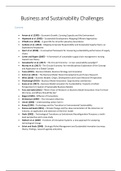Samenvatting
BSC Summary of Literature and Key Concepts for Final Exam
This summary can be used as preparation for the final exam of the course: "Business and Sustainability Challenges" in the Sustainable Business and Innovation Master's at Utrecht University. It contains summaries of the literature used in the course during . Content page is made explicit in order to...
[Meer zien]




